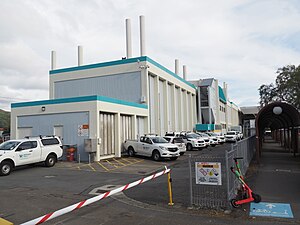Waterloo, New Zealand
Waterloo | |
|---|---|
 Waterloo Water Treatment Plant | |
 | |
| Coordinates: 41°13′01″S 174°55′34″E / 41.217°S 174.926°E | |
| Country | New Zealand |
| City | Lower Hutt |
| Local authority | Hutt City Council |
| Electoral ward | Eastern Ward |
| Area | |
| • Land | 181 ha (447 acres) |
| Population (June 2023)[2] | |
| • Total | 5,800 |
| Train stations | Waterloo |
| Lower Hutt CBD | Epuni | Fairfield |
| Woburn |
|
|
| Waiwhetū |
Waterloo is an eastern suburb of Lower Hutt, Wellington. It is named after the Battle of Waterloo won by the Duke of Wellington in 1815.[3]
The Hutt City Council formally defines Waterloo as the area bounded by Waterloo Road and Burnside Street in the north, the Hutt Valley railway line in the west, Guthrie Street in the south, and the Wainuiomata hills in the east.[4]
It is the home suburb to Waterloo Primary School and the Open Polytechnic of New Zealand. It is also home to Waterloo Interchange, a major train and bus station.
Demographics[edit]
Waterloo, comprising the statistical areas of Waterloo West and Waterloo East, covers 1.81 km2 (0.70 sq mi).[1] It had an estimated population of 5,800 as of June 2023, with a population density of 3,204 people per km2.
| Year | Pop. | ±% p.a. |
|---|---|---|
| 2006 | 5,136 | — |
| 2013 | 5,124 | −0.03% |
| 2018 | 5,379 | +0.98% |
| Source: [5] | ||
Waterloo had a population of 5,379 at the 2018 New Zealand census, an increase of 255 people (5.0%) since the 2013 census, and an increase of 243 people (4.7%) since the 2006 census. There were 2,013 households, comprising 2,598 males and 2,784 females, giving a sex ratio of 0.93 males per female, with 1,068 people (19.9%) aged under 15 years, 951 (17.7%) aged 15 to 29, 2,562 (47.6%) aged 30 to 64, and 801 (14.9%) aged 65 or older.
Ethnicities were 70.2% European/Pākehā, 10.2% Māori, 5.1% Pasifika, 22.2% Asian, and 2.6% other ethnicities. People may identify with more than one ethnicity.
The percentage of people born overseas was 29.0, compared with 27.1% nationally.
Although some people chose not to answer the census's question about religious affiliation, 48.2% had no religion, 37.1% were Christian, 0.5% had Māori religious beliefs, 5.1% were Hindu, 1.0% were Muslim, 1.3% were Buddhist and 2.0% had other religions.
Of those at least 15 years old, 1,410 (32.7%) people had a bachelor's or higher degree, and 579 (13.4%) people had no formal qualifications. 1,089 people (25.3%) earned over $70,000 compared to 17.2% nationally. The employment status of those at least 15 was that 2,274 (52.7%) people were employed full-time, 603 (14.0%) were part-time, and 156 (3.6%) were unemployed.[5]
| Name | Area (km2) |
Population | Density (per km2) |
Households | Median age | Median income |
|---|---|---|---|---|---|---|
| Waterloo West | 0.73 | 2,283 | 3,127 | 849 | 39.5 years | $36,200[6] |
| Waterloo East | 1.08 | 3,096 | 2,867 | 1,164 | 40.6 years | $39,000[7] |
| New Zealand | 37.4 years | $31,800 |
Education[edit]

Waterloo School is a co-educational state primary school for Year 1 to 6 students,[8][9] with a roll of 482 as of February 2024.[10]
The Open Polytechnic of New Zealand, a subsidiary of Te Pūkenga, is in Waterloo.[11]
Waiwhetū Stream[edit]
The Waiwhetū Stream is a small watercourse that flows through Waterloo and drains the eastern side of the Hutt Valley. It enters Wellington Harbour at the Hutt River estuary. Development and urbanisation of the Hutt Valley since the arrival of settlers led to increasing pollution and degradation of the stream environment. The stream was diverted into concrete culverts in many sections in an attempt to reduce flooding. Industrial development in the area around the lower reaches of the stream led to that section becoming an industrial sewer. In 2010, the stream was described as one of the most polluted waterways in New Zealand.[12]
Pressure from the community beginning around 2003 helped to trigger a major project to clean up the lower reaches. This project was declared complete in June 2010, after the removal of 56,000 tonnes of toxic waste. In 2010-11, a community group was formed to lead restoration of the upper reaches of the stream. Over a period of 10 years, volunteers cleared invasive aquatic weeds and rubbish from 6 kilometres (3.7 mi) of the stream bed and established around 34,000 locally-sourced native plants on the banks of the stream.[13]
References[edit]
- ^ a b "ArcGIS Web Application". statsnz.maps.arcgis.com. Retrieved 12 June 2021.
- ^ "Population estimate tables - NZ.Stat". Statistics New Zealand. Retrieved 25 October 2023.
- ^ Te Ara: The Encyclopaedia of New Zealand – Hutt Valley – central and west Retrieved: 10 January 2009
- ^ "Hutt City Wards and Suburbs" (PDF). Hutt City Council. Retrieved 3 November 2015.
- ^ a b "Statistical area 1 dataset for 2018 Census". Statistics New Zealand. March 2020. Waterloo West (245500) and Waterloo East (246100).
- ^ 2018 Census place summary: Waterloo West
- ^ 2018 Census place summary: Waterloo East
- ^ "Waterloo School Official School Website". waterloo.school.nz.
- ^ "Waterloo School Education Review Office Report". ero.govt.nz. Education Review Office.
- ^ "Waterloo School Ministry of Education School Profile". educationcounts.govt.nz. Ministry of Education.
- ^ "Who We Are". Open Polytechnic. Retrieved 12 June 2023.
- ^ "Budget blowout in cleanup of toxic Waiwhetu Stream". Dominion Post. 1 February 2010. ProQuest 507114045.
- ^ Boyack, Nicholas (6 September 2023). "Friends win battle against South African invasive weeds". The Post. Retrieved 6 September 2023.
